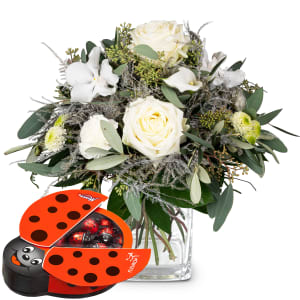What New Year's Eve food brings luck and what is a no-go?
Which New Year's Eve foods bring good luck and what is a no-go? We have looked around the kitchens of various countries to help you plan your end-of-year meal.



Pigs stand for luck, prosperity and fertility
Since a pig apparently cannot go backwards and is always burrowing forwards, it brings good energy for the new year and helps to avoid regression and failure.
Pigs generally stand for luck, prosperity, wealth and fertility.
That is why they are a must in Brazil, Finland, Italy, Austria, Sweden, Spain, the Czech Republic and Hungary, for example, whether in the form of a roast, cotechino, stuffed pork's foot (zampone), pork's head, pork knuckle or aspic.
Of course, the lucky marzipan pigs are also part of the table decorations on New Year's Eve.



Lentils (and beans) stand for money blessings
As the shape of the lentils is reminiscent of coins, they are served at the turn of the year in countries such as Italy and Hungary.
They stand for monetary blessings. As children don't always like lentils, it has become customary in many places to tell them that there is a golden lentil hidden in the dish that needs to be found.
So: eat up! In some countries (e.g. Brazil, Portugal and Hungary), beans are also regarded as lucky charms. Perhaps because they are reminiscent of gold nuggets.



Fishes - promise money and a bright future
In countries such as Germany, China, Poland, Portugal and Scandinavia, fish is part of the New Year.
In Germany and Poland, it is herring or carp, with a dried scale in the wallet being a symbol of plenty of money in the new year.
In Brazil, it's mainly bacalhau (salted cod), in Scandinavia boiled cod or fish salad and in China the whole fish from head to tail fin.

Long noodles and salad promise long life and happiness
Salad – really? Yes. Because in China, the word salad sounds like the word for luck.
That's why people in the Middle Kingdom eat lettuce wraps at the turn of the year and fill them with other ingredients that bring good luck.
In Japan and the Philippines, on the other hand, long noodles bring good luck. But be careful: they must not break apart or chopped when eaten!



Chicken, turkey and lobster are often no-goes
If you are superstitious, you should avoid chicken and turkey meat at the end of the year.
The animals are avoided because they scratch backward and bring old problems into the new year. What's more, they have wings ... and there is a risk that luck will fly away with them.
The lobster, on the other hand, can also move backwards and is therefore symbolic of possible setbacks.
So, if you want to play it safe, don't bring it to the table at the turn of the year.
More about New Year's Eve & New Year
About the turn of the year and the name «Sylvester»
What does the turn of the year mean to you? What symbolism did it have in the past? And what is behind the name «Sylvester»? You can find the answers here.
Who is toasting the New Year and when?
When we are sitting at lunch on December 31, people elsewhere are celebrating the turn of the year. Others are only ready when we wake up hungover on January 1.
Several beginnings of the year at the same time?
The new year begins on January 1. But there used to be up to six beginnings of the year, sometimes even several at the same time. The development of the names of the months is also exciting.
What New Year's Eve food brings luck and what is a no-go?
Which New Year's Eve foods bring good luck and what is a no-go? We have looked around the kitchens of various countries to help you plan your end-of-year meal.
The largest and most famous fireworks display worldwide
Starry rain at the turn of the year? Not only here. Because impressive pyro shows in a class of their own take place in the world's major cities.
Flowers at the turn of the year? Unexpected and beautiful.
Text message or phone call at the turn of the year? Normally OK. But what if someone really means a lot to you? Try surprising them with flowers.









